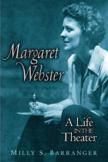Lady in Lights
A pioneering 20th-century stage and opera director, Margaret Webster challenged not only stage tradition but also mainstream attitudes toward professional women.
A creative force in the United States and Great Britain, Webster is credited with bringing Shakespeare to Broadway. Her bold casting of Paul Robeson in the role of Othello in 1943 at the Shubert Theatre is considered a milestone in theater history.
The author Milly Barranger (Alumni Distinguished Professor at the University of North Carolina at Chapel Hill) devotes an entire chapter of this first-rate biography to explaining that production’s genesis, from the time Robeson approached Webster asking her to direct him in the play’s title role, through casting and early performances off Broadway at the Brattle Theatre in Cambridge, Mass., and Princeton’s McCarter Theatre.
When Othello finally ran in New York, the production had, according to Barranger, an enormous impact on the careers of African American actors in the American commercial theatre, on the beginnings of multiracial casting in companies, and on the perception of William Shakespeare as a box office’ playwright.
Webster’s production of Othello illustrates the director’s independent nature and her disregard of archaic stage traditions. Just as she refused to acknowledge the unwritten rules about who may and may not appear on stage, Webster ignored the contemporary wisdom about a woman’s proper place in the profession.
Since she aspired to follow in her parents’ theatrical footsteps, Margaret Webster began working as an actress in England. Relegated to minor roles in largely undistinguished plays, Webster veered toward the director’s chair when Maurice Evans offered her the opportunity to direct him in a repertory of four plays in New York during the 1937 season.
Why Evans made this offer is a bit of a mystery. Webster did not have any comparable experience in the West End, nor had she shown much enthusiasm for directing as a full-time career, yet she accepted the position. Some people feel her strong Shakespearean background was a determining factor in the offer, while others believe May Whitty, Webster’s mother, may have exerted some pressure on Evans to bring her daughter to New York. At any rate, convinced he could influence Webster’s artistic decisions and control the production from center stage, Evans made the offer and the 31-year-old actress said yes.
Calling her subject a phenomenon in the Broadway theatre of 1937, Barranger explains that a woman director hired for a Broadway production, and a Shakespearean play to boot, was a closely scrutinized event. Surprising the skeptics and delighting theater lovers, Webster did an admirable job. As the productions captured the imaginations of Broadway’s theatergoers and the acclaim of the critics, Margaret Webster had launched a new career.
By the late 1930’s she was in demand as a director and was working with the biggest names in the business. Never completely turning her back on acting, she also found the time to hone her skills as a character actress. Barranger writes that Brooks Atkinson, calling Webster the ablest woman in our theatre, bemoaned the fact she did not appear frequently enough on the Broadway stage.
Another milestone in her career was reached in 1950 when Webster was asked by Rudolf Bing, the general manager of the Metropolitan Opera Company, to stage Verdi’s Don Carlo, which would be the opening opera of the new season.
This new venture into opera was as successful as her other endeavors. But at the same time as she was paging through the libretto and consulting with the set designer Rolf Gerard, who was also making his Met debut, Webster came under the scrutiny of the House un-American Activities Committee. She went before Senator Joseph McCarthy’s infamous subcommittee in 1953.
In retrospect, this time represented some of the most pronounced highs and lows in Webster’s life. The turmoil associated with the McCarthy committee hearing, the deaths of some family members and changes in her own personal relationships were devastating. On the other hand, the opera productions she staged were well received, and Webster continued directing both on Broadway and in Great Britain.
Up to the day of her death at the age of 67, Webster remained active in the theater. Although dying of cancer, she was still making plans to record a series of dramatic readings for a New York production company.
Milly Barranger has written the definitive biography of Margaret Webster, providing a fascinating glimpse into the director’s personal and family life, while chronicling every aspect of Webster’s professional career. It seems nothing has been omitted from the story. Webster’s successes and failures, her blemishes and her laudable characteristics, and the highs and the lows of a long life are all here.
This article also appeared in print, under the headline “Lady in Lights,” in the December 13, 2004, issue.








